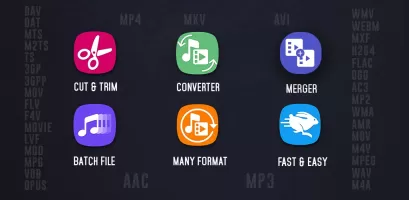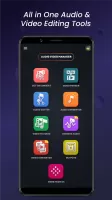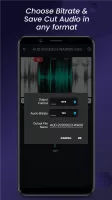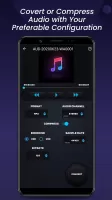Video Cutter, Trimmer & Merger - Edit video clips
Effortlessly trim, cut, and merge videos with precision and ease.

- 15.6.0 Version
- 4.7 Score
- 1M+ Downloads
- In-app purchases License
- 3+ Content Rating
Fastest video audio editor application available on the market that enables users to trim and cut both audio and video files efficiently. It supports conversion from a wide range of video formats to audio and video formats, making it the ultimate tool for cutting, trimming, and converting media files.
Supported Formats:
MP3, AAC(M4A,M4B), AC3, WAV, OGG, FLAC, MP4, MKV, AVI, 3GP, FLV, MOV, WEBM, M2TS, TS, MTS, MPEG.
Key Features:
- Trim and Cut Audio files: Supports MP3, AAC(M4A,M4B), AC3, WAV, OGG, FLAC formats.
- Trim and Cut Video files: Supports MP4, MKV, AVI, 3GP, FLV, MOV, WEBM, M2TS, TS, MTS, MPEG etc.
- Convert various audio formats like MP3, AAC(M4A,M4B), AC3, WAV, OGG, FLAC, OPUS to other Audio formats and MP4 format.
- Convert video formats such as MP4, MKV, AVI, 3GP, FLV, MOV, WEBM, M2TS, TS, MTS, MPEG to audio formats including MP3, AAC, AC3, WAV, OGG, M4A, FLAC.
- Batch Audio file conversion.
- Batch Video To Audio Conversion.
This app offers faster processing speeds compared to other similar applications in the market, saving users significant time.
Feature Description:
- The Audio Cutter section is dedicated to cutting and trimming audio files.
- The Video Cutter section allows users to cut and trim video files.
- The Video to Audio section specializes in converting and compressing videos into mp3 format.
- Each section of the editing app includes a built-in video player and audio player for previewing audio and video content before editing.
This software utilizes code from FFmpeg licensed under the LGPLv2.1, with its source code available for download. Instructions for compiling and building the library can be found in the readme file within the source. The program acknowledges the use of libraries from the FFmpeg project under the LGPLv2.1 license.
About Video Cutter, Trimmer & Merger
Video Cutter, Trimmer & Merger is a tools app developed by Inverse AI. The APK has been available since November 2018. In the last 30 days, the app was downloaded about 3.3 thousand times.
It's currently not in the top ranks.
It's rated 4.64 out of 5 stars, based on 27 thousand ratings. The last update of the app was on October 3, 2024. Video Cutter, Trimmer & Merger has a content rating "Everyone".
Video Cutter, Trimmer & Merger has an APK download size of 32.57 MB and the latest version available is 8.0.1. Designed for Android version 5.0+. Video Cutter, Trimmer & Merger is FREE to download.
The Impact of AI on Video Editing
The Impact of AI on Video Editing is a transformative shift, redefining the craft of video production. AI technology in video editing incorporates sophisticated algorithms capable of performing tasks that once required extensive human effort. These intelligent systems analyze and manipulate video content, leading to enhanced efficiency and creativity.
Key benefits of using AI-powered video editing software include:
- Time Efficiency: Automated editing and effects streamline the production process, reducing the time spent on manual tasks.
- Consistency: AI maintains uniformity across various aspects of video editing, ensuring a professional look and feel.
- Accessibility: Simplified tools empower users at all skill levels to produce high-quality content.
- Innovation: AI’s analytical capabilities push the boundaries of traditional video editing, allowing for the creation of new visual styles and narratives.
AI-driven solutions
AI-driven solutions are reshaping the landscape of video production, offering unprecedented opportunities for professionals and enthusiasts alike to refine their craft with precision and flair.
1. Improved Video Quality
Video quality is crucial in grabbing an audience’s attention and conveying a message effectively. AI algorithms play a major role in enhancing this aspect, turning good footage into stunning visuals. Here’s how:
AI-Powered Noise Reduction
Grainy or noisy footage is a common issue in video production, especially in low-light situations. AI algorithms are excellent at analyzing these flaws frame by frame, distinguishing between noise and actual details. The result? A cleaner, sharper image without losing any important features.
Intelligent Sharpening Techniques
Getting the right level of sharpness can make all the difference between an amateur-looking video and one that looks professional. AI sharpening tools work by examining the content of each scene and making precise adjustments to edges and textures. This creates a more defined and visually appealing end product.
Examples of these technologies in action include software like Adobe Premiere Pro and Final Cut Pro, which use AI to help with tasks like improving resolution without sacrificing quality, or DaVinci Resolve’s neural engine that applies advanced noise reduction algorithms with user-friendly controls.
These advancements in video editing not only enhance the visual quality but also save a significant amount of time during post-production. This allows editors to concentrate on storytelling and other creative aspects of their projects. With AI constantly evolving, videos are becoming more than just cleaner or sharper — they’re getting closer to the creator’s vision with unmatched precision.
2. Streamlined Editing Process with Automation
AI plays a crucial role in video editing by automating time-consuming tasks like color correction and audio enhancement. With the help of machine learning algorithms, AI-powered tools can quickly and accurately apply color grading to multiple clips, ensuring a consistent look without manual adjustments.
Color Correction
Achieving the perfect color balance in every scene used to require a lot of time and effort. But with AI, it’s much easier:
The algorithm analyzes each frame to ensure consistent colors throughout the video.
It automatically applies color grades based on predefined styles or reference images.
The AI tool can also adapt to different lighting conditions within the clips, making sure everything looks just right.
Audio Enhancement
Good audio is just as important as good visuals in video production. Here’s how AI can help improve your audio quality:
It identifies and reduces background noise, making dialogue clearer.
The tool balances audio levels between dialogue, music, and sound effects for a more immersive experience.
It enhances voice clarity and adjusts EQ settings to suit the mood and atmosphere of each scene.
The introduction of automated workflows powered by AI not only saves editors countless hours but also ensures that the final product meets high-quality standards with minimal human intervention. As a result, you can focus more on creative storytelling and less on technical tweaks.
By integrating these smart technologies into your workflow, you enjoy benefits such as:
- Reduced production time and costs
- Consistent output quality across projects
- Ability to handle large volumes of content swiftly
Through these advancements, AI empowers you to maintain an edge in productivity while delivering polished videos that stand out in today’s content-rich digital landscape.
3. Enhancing Creativity through Intelligent Analysis
AI-powered tools are changing the way videos are edited, combining technical skill with artistic style. With the introduction of visual analysis, editors can now dig deeper into the content, leading to a more engaging storytelling experience. Advanced AI algorithms offer:
- Scene Detection: By recognizing different scenes and their elements, AI helps in dividing videos automatically which can be especially helpful in large projects.
- Suggestion Algorithms: These provide recommendations for edits based on extensive datasets of successful video sequences, making it easier for editors to make decisions.
This smart analysis not only helps improve what is already captured, but also sparks new ideas and perspectives during the editing process. For example, an editor might use scene detection to create smooth transitions that they might have missed otherwise.
Moreover, this technology can analyze how fast or slow scenes are paced and suggest changes to achieve the desired emotional impact or narrative flow. Such insights give editors the confidence to make thoughtful creative choices, enhancing the storytelling without losing their artistic vision.
By incorporating these AI-generated insights into their workflow, video editors can explore endless possibilities that were previously limited by time or technology. As a result, they discover new avenues in video creativity and storytelling.
4. The Rise of Personalized and Accessible Editing Tools
The world of video editing is changing thanks to new AI-driven technologies that prioritize making editing easier without sacrificing power or capability. These advanced tools are removing technical barriers, allowing more people to try video editing, no matter their previous experience or skills.
How AI is Changing the Game
Tailoring the Experience
AI-driven innovations are leading the way, customizing the editing process based on each person’s skill level and needs.
Lowering the Barrier
With user-friendly interfaces, these tools make it easier for beginners to get started while still offering advanced options for professionals.
Adaptive Difficulty Levels
AI-powered software now has different levels of difficulty, making it simpler for beginners to do complex tasks using easy drag-and-drop actions and one-click improvements. At the same time, they still have advanced features like keyframing and multi-track editing for experienced editors who want precise control over their projects.
Personalized Tools for Every Style
These customized tools aren’t just about being easy to use; they also work well with different creative styles and workflows. Whether you’re making a short film or a social media clip, the AI in these platforms can:
- Suggest edits
- Apply stylistic elements
- Recommend narrative structures that match your content’s purpose
Embracing Individuality
The inclusion of AI in video editing software ensures that each person’s experience is special and tailored to their own goals. This opening up of video editing to more people sets the stage for a new generation of content creators who are empowered by technology that understands and adjusts to their unique creative process.
Balancing Act: Human Creativity in the Age of Automation
Despite the sophistication of AI in video editing, the human touch remains irreplaceable. Human creativity and storytelling are not just about cutting and stitching clips; they involve understanding emotion, cultural nuances, and the subtle art of narrative pacing that AI cannot fully replicate. Video editing is as much an art form as it is a technical process.
Human touch in video editing:
- Emotional Intelligence: Editors add value by interpreting emotional cues and crafting a story that resonates with viewers on a human level.
- Cultural Context: Humans bring an awareness of societal norms and trends, ensuring content is relevant and impactful to its intended audience.
- Artistic Flair: Unique stylistic choices, innovative transitions, and unexpected visual effects are born from human imagination.
- Storytelling Mastery: Crafting a compelling narrative arc requires a deep understanding of storytelling principles that goes beyond algorithmic suggestions.
AI technology serves as a powerful tool in the editor’s arsenal but does not overshadow the expertise and insight that human editors provide. By combining AI capabilities with human ingenuity, the resulting synergy elevates the craft of video editing to new heights. The landscape of video editing is being reshaped by AI, yet the core of what makes a video captivating — its heart and soul — stems from the creative minds behind the lens.
Democratizing Video Editing with AI
The development of AI has revolutionized the video editing landscape by making sophisticated editing tools more accessible to a wider audience. Here are some key points to consider:
- Cloud-Based Solutions: AI-powered video editing solutions have transitioned towards cloud-based platforms, eliminating the need for high-end hardware and expensive software licenses. This shift allows users to access powerful editing tools through web browsers, reducing barriers to entry for aspiring editors.
- Cost-Effective Accessibility: The affordability of AI-driven video editing tools has democratized the industry, enabling individuals with limited resources to create professional-quality content. These cost-effective solutions open doors for independent creators, small businesses, and educational institutions to engage in high-quality video production.
AI’s impact on video editing extends beyond enhancing technical capabilities; it also plays a pivotal role in fostering inclusivity and diversity within the creative community. By embracing AI-powered tools, individuals can amplify their storytelling and artistic expression regardless of financial constraints or technical expertise.
Embracing the Future of AI-Driven Video Editing
As AI technology continues to advance, it is important for video editors to look ahead and consider the evolving role of AI in shaping the future of video editing. Rather than fearing or resisting these advancements, video editors can embrace and adapt to the opportunities brought by AI.
Here are some key points to consider:
1. Collaboration between Humans and Machines: The future of video editing lies in a collaborative approach between humans and AI. While AI can automate repetitive tasks and enhance efficiency, human creativity is still essential for storytelling and bringing unique perspectives to the craft. Video editors should view AI as a tool that complements their skills and enhances their creative process.
2. Continuous Learning and Adaptation: As AI technology evolves, video editors need to stay updated with the latest advancements. This includes learning new AI-driven tools and techniques that can improve their editing workflows. By continuously adapting to new technologies, video editors can unlock new possibilities and push the boundaries of their creativity.
3. Exploring New Possibilities: AI opens up a world of possibilities in video editing. For example, AI-powered tools can analyze vast amounts of data to suggest creative decisions based on previous successful edits or industry trends. Video editors should be open to exploring these new possibilities and experimenting with AI-driven features to enhance their editing process.
4. Ethical Considerations: As AI becomes more integrated into video editing workflows, it is important for video editors to consider ethical implications. This includes issues such as deepfake technology, which can manipulate videos in ways that raise concerns about misinformation or privacy. Video editors should use AI technology responsibly and be aware of its potential impact on society.
By embracing the future of AI-driven video editing, video editors can harness the power of automation, efficiency, and intelligent analysis while still maintaining their unique creative perspective. It is through this balance between humans and machines that the true potential of AI in video editing can be realized.
- Version15.6.0
- UpdateSep 05, 2025
- DeveloperInverse Ai
- CategoryTools
- Requires AndroidAndroid 7.0+
- Downloads1M+
- Package Namecom.inverseai.audio_video_manager
- Signature76e4534907b8e6bebe8824c0f0b52ebf
- Available on
- ReportFlag as inappropriate
-
NameSizeDownload
-
49.37 MB
-
50.94 MB
-
50.94 MB
































no paywalls and many options
easy convertion
Cuts the audio without changing quality
cut selected option is is changed and unusable
destroys the music after reducing the noice